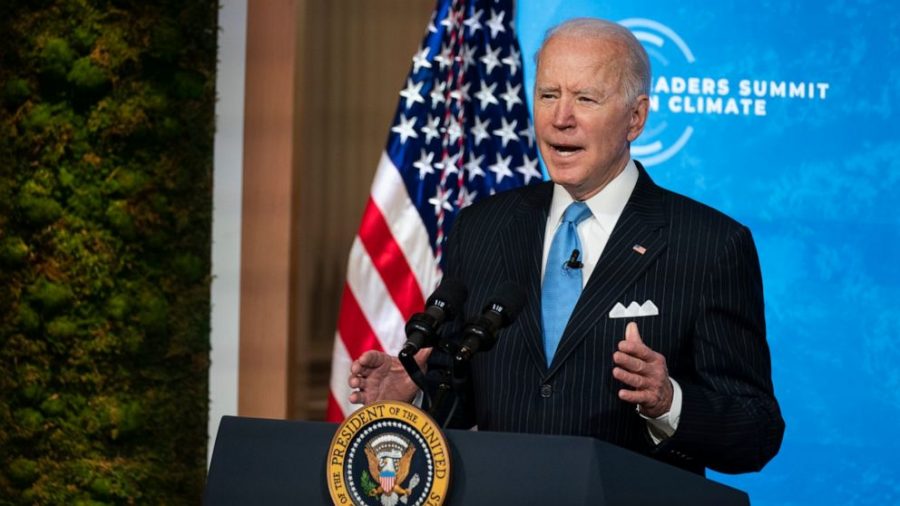Hopes vs. Outcomes: Environmentally Aware Students on Biden’s Leaders Summit On Climate
Biden speaks at the Leaders Summit On Climate. The virtual summit was held on Earth Day with the goal of increasing both the United States and other nations’ climate ambition.
May 5, 2021
Climate Goals. Climate action is a main focus for the current administration, with President Joe Biden calling climate change the top issue humanity must confront back in October 2020 before his election to the White House.
On his first day in office, Biden rejoined the Paris Agreement and has made it clear he does not plan to stop there. He quickly organized the Leaders Summit On Climate where he asked the 40 leaders he invited to share their country’s plans to commit to ambitious climate targets alongside the U.S.
According to Vox News, “The goal is to collectively put the world on track to prevent a 1.5-degree Celsius rise above pre-industrial levels.”
Prior to the summit, environmentally conscious Sage Creek students expressed their hopes for and feelings about the event and the state of the climate. Here is how these feelings compare to the outcomes of the summit.
Goals for the U.S.
On Earth Day, Biden announced the U.S.’s updated goal to reduce the nation’s emissions to between 50% and 52% of the country’s 2005 emission levels by 2030. This was a substantial increase from the U.S.’s prior goal of a between 26% and 28% reduction of 2005 levels by 2025, made during President Barack Obama’s administration.
Kennedy Parker, the president of the SCHS Environmental Club, believes the United States should be aiming to reduce its emissions to far less than half.
“We need to protect our environment if we want the earth to keep going,” she said.
Although she hoped to see the United States commit to a larger number than a 50% reduction in emissions, she understands the Biden administration’s caution when it comes to announcing the scale of their plans due to the vocality of climate deniers and conservative citizens who may not get behind a more ambitious goal.
Parker’s fellow Environmental Club leader, Aria Phan, who serves as Vice President of the group, agrees.
She described her feelings toward the expected goal saying, “It’s not too intimidating for other people and it is something that seems achievable because if you make too big of a goal…a lot of people will be too intimidated to reach for it…and it’s harder to enforce.”

Goals Abroad
The U.S. is the second-largest emitter of CO2 on the planet (behind China), putting the nation in a powerful position when it comes to limiting CO2 emissions in the future.
Despite this, Parker believes the actions of every nation are critical in the decarbonization process.
“Climate change is a global issue and it’s not something that we should be individually tackling; we should all try to work together to solve it,” she expressed.
At the summit, other key nations released their climate targets and expectations regarding their nations’ emissions in the coming decades.
China’s President Xi Jinping announced that the nation will work to decline its use of coal for energy generation between 2025 and 2030.
Justin Trudeau, the Prime Minister of Canada, released the nation’s updated emissions target, raising it from a 30% decrease to a 40% to 45% decrease below 2005 emissions levels.
More nations, including Japan and Brazil, also released their projections for the coming years.
“All countries should simply cut as many [emissions] as possible,” Makena Hersh, an environmentally aware junior at SCHS, said, “It’s very important that every country has an ambitious goal.”
Hersh not only feels it is important that every country step up with a climate goal, but that nations support each other in the process. She thinks it is necessary to think about the differences in resources that each nation has access to.
“[There] are developing nations [that] are possibly underfunded or undersupplied; they need…extra help in order to reach these goals,” she said.
This sentiment may come to fruition. According to Robert Bradley, a director at the NDC Partnership (a group that helps countries build attainable climate targets), “Developing countries are expected to reduce emissions alongside developed countries, but in return, they are entitled to financial support.”

The Significance
This gathering of world leaders holds implications for the future as the effects of climate change become more apparent.
According to NASA, climate change is already happening, and that is not going to stop. Despite this, being proactive could help limit or avoid the worst of the climate catastrophes to come.
“Responding to climate change will involve a two-tier approach: 1) ‘mitigation’ – reducing the flow of greenhouse gases into the atmosphere; and 2) ‘adaptation’ – learning to live with, and adapt to, the climate change that has already been set in motion,” the Earth Science Communications Team at NASA wrote.
Biden’s climate summit is a part of the nations and the globe’s “mitigation” plans.
More information regarding world leaders’ next steps and plans of action will become known during the UN Climate Change Conference that will take place in Glasgow, Scotland, on Nov. 1-12, 2021.






